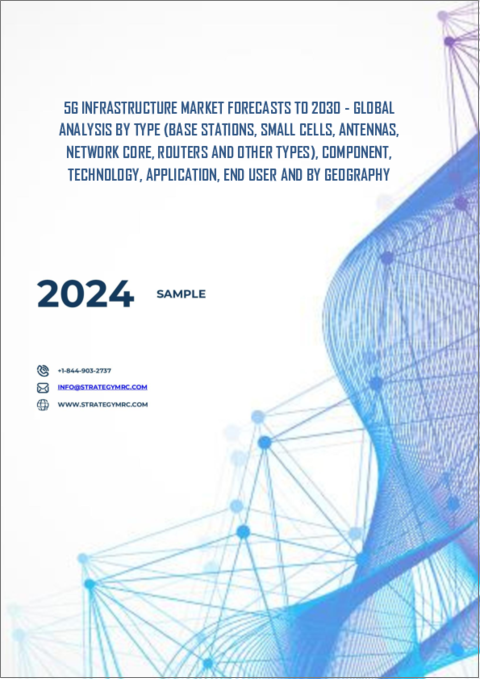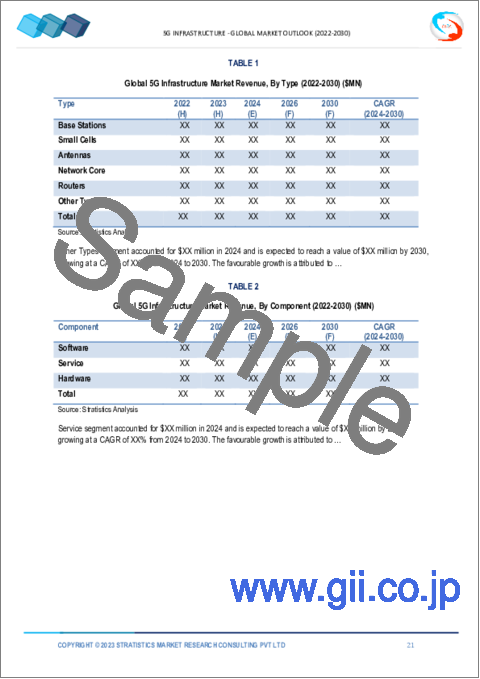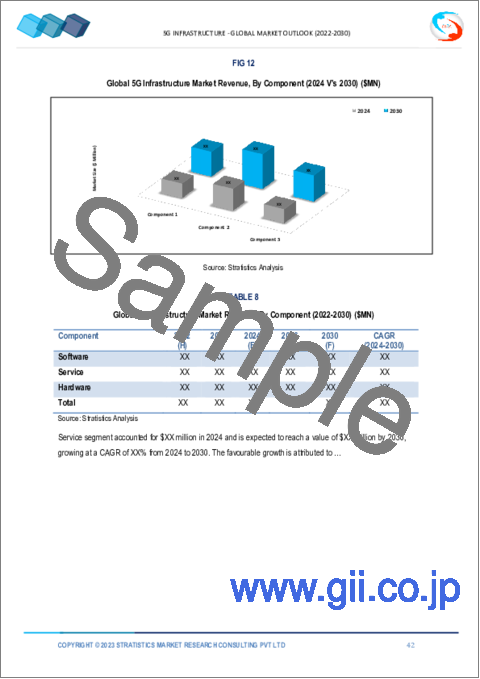|
|
市場調査レポート
商品コード
1494775
5Gインフラ市場の2030年までの予測: タイプ別、コンポーネント別、技術別、用途別、エンドユーザー別、地域別の世界分析5G Infrastructure Market Forecasts to 2030 - Global Analysis By Type (Base Stations, Small Cells, Antennas, Network Core, Routers and Other Types), Component, Technology, Application, End User and By Geography |
||||||
カスタマイズ可能
|
|||||||
| 5Gインフラ市場の2030年までの予測: タイプ別、コンポーネント別、技術別、用途別、エンドユーザー別、地域別の世界分析 |
|
出版日: 2024年06月06日
発行: Stratistics Market Research Consulting
ページ情報: 英文 200+ Pages
納期: 2~3営業日
|
- 全表示
- 概要
- 図表
- 目次
Stratistics MRCによると、世界の5Gインフラ市場は2024年に122億米ドルを占め、予測期間中のCAGRは38.2%で成長し、2030年には851億米ドルに達すると予測されています。
5Gインフラは、第5世代無線通信をサポートするために必要なハードウェア、ソフトウェア、プロトコルの包括的なネットワークを包含します。アンテナ、基地局、ルーター、サーバーで構成され、光ファイバーケーブルなどの高速接続で相互接続されています。このインフラは、超高速データ伝送、低遅延、広大な接続性を可能にし、モノのインターネット(IoT)、自律走行車、拡張現実(AR)などの先進技術の展開を促進します。
GSMAによると、5Gネットワークは初期の導入試験で45%の都市カバレッジを達成しています。ドイツ連邦ネットワーク庁の5G周波数指令によると、2022年までにドイツの家庭の98%が高速モバイルインターネットを利用できるようにしなければならないです。
モバイル・データ・サービスへの需要の高まり
市場では、接続デバイスの急増と帯域幅を大量に消費するアプリケーションの人気の高まりによって、モバイルデータサービスに対する需要が急増しています。5Gが約束する高速化、低遅延化、ネットワークの信頼性向上により、消費者も企業も、動画ストリーミングからIoT展開まで、モバイルデータへの依存度を高めています。このような需要の高まりは、通信とデジタル接続の未来を形作る上で、5Gインフラが極めて重要な役割を担っていることを裏付けています。
展開とカバレッジの課題
この市場は、より広い帯域幅を提供するもの、通信距離と普及能力に限界がある高周波数帯域に起因する展開とカバレッジの課題に直面しています。広範なカバレッジを実現するには、小規模なセルを密集させたネットワークが必要となり、展開コストと複雑さが増します。こうしたハードルを克服するには、コストを効果的に管理しながらカバレッジを最適化するネットワーク・スライシングや高度なビームフォーミング技術などの革新的なソリューションが必要です。
モノのインターネット(IoT)の成長
市場におけるモノのインターネット(IoT)の成長は目覚ましいです。5G技術の登場により、IoTデバイスはかつてない接続性、スピード、信頼性を体験し、さまざまな分野での採用が急増しています。IoTと5Gインフラの相乗効果は、スマートシティ、ヘルスケア、製造業などのイノベーションに拍車をかけています。シームレスで広帯域幅の接続に対する需要が高まるにつれ、5Gの業界情勢におけるIoTエコシステムは飛躍的な拡大を遂げ、産業の再形成と効率性の強化が見込まれています。
高い初期資本支出
この市場の特徴は、初期資本支出が大きいことです。5Gネットワークの展開には、基地局、アンテナ、光ファイバーケーブルなどのハードウェアや、ソフトウェア、インフラのアップグレードに多額の投資が必要となります。5G技術の高速化と接続需要に対応するためには、広範なネットワークカバレッジと容量拡張が必要なため、これらの初期費用は相当なものになる可能性があります。
COVID-19の影響:
COVID-19の大流行は、5Gインフラ市場を阻害すると同時に加速させました。当初、サプライチェーンの混乱と労働力の制限が展開を遅らせた。しかし、リモートワーク、オンライン教育、デジタルヘルスケアサービスへの依存度が高まったことで、堅牢な通信ネットワークの重要性が浮き彫りになり、5Gインフラへの投資が促進されました。その結果、短期的な挫折にもかかわらず、パンデミックは最終的に5Gインフラ市場の長期的な成長見通しに拍車をかけた。
予測期間中、基地局セグメントが最大になる見込み
予測期間中、基地局セグメントは最大となる見込みです。これらの基地局は5Gネットワークのバックボーンとして機能し、高速データ伝送と低遅延通信を可能にします。シームレスな接続に対する需要が高まるにつれ、拡大するネットワークカバレッジと容量要件をサポートするために、基地局の配備が重要になります。さらに、技術の進歩が基地局の性能と効率を高め、5Gエコシステムでの採用をさらに促進しています。
予測期間中、スマートシティセグメントのCAGRが最も高くなる見込み
スマートシティ分野は、予測期間中に最も高いCAGRが見込まれます。この相乗効果により、リアルタイムのデータ収集と分析が可能になり、交通、エネルギー、ヘルスケアなど様々な分野での効率性、持続可能性、接続性の強化が促進されます。超高速で低遅延の5Gは、IoTデバイス、自律走行車、スマートグリッドをサポートし、イノベーションを促進して生活の質を向上させる。政府と産業界がこの変革技術に投資することで、5Gインフラにおけるスマートシティ市場は飛躍的な成長を遂げ、都市環境をより良いものに再構築する態勢が整っています。
最大のシェアを占める地域
予測期間中、北米が最大の市場シェアを占めると予測されます。通信大手がインフラ開拓に巨額の投資を行っており、市場は急拡大しています。主要企業は、ネットワーク容量とカバレッジを強化する先進技術の導入に注力しています。さらに、5Gの展開を支援する政府の取り組みが、市場の成長をさらに後押ししています。全体として、5Gインフラ開発の最前線に立ち、今後数年で大きく拡大する態勢が整っています。
CAGRが最も高い地域:
アジア太平洋地域は、高速インターネット接続に対する需要の増加、技術の進歩、5Gの導入を促進する政府の取り組みにより、予測期間中に最も高いCAGRを維持すると予測されます。韓国も5G技術のパイオニアとして台頭しており、主要都市で5Gネットワークが広くカバーされ、採用されています。5Gネットワークの展開は、通信、ヘルスケア、製造、輸送などの業界に革命をもたらし、企業と消費者に新たな機会をもたらすと期待されています。
無料カスタマイズサービス:
本レポートをご購読のお客様には、以下の無料カスタマイズオプションのいずれかをご利用いただけます:
- 企業プロファイル
- 追加市場プレーヤーの包括的プロファイリング(3社まで)
- 主要企業のSWOT分析(3社まで)
- 地域セグメンテーション
- 顧客の関心に応じた主要国の市場推計・予測・CAGR(注:フィージビリティチェックによる)
- 競合ベンチマーキング
- 製品ポートフォリオ、地理的プレゼンス、戦略的提携に基づく主要企業のベンチマーキング
目次
第1章 エグゼクティブサマリー
第2章 序文
- 概要
- ステークホルダー
- 調査範囲
- 調査手法
- データマイニング
- データ分析
- データ検証
- 調査アプローチ
- 調査情報源
- 1次調査情報源
- 2次調査情報源
- 前提条件
第3章 市場動向分析
- 促進要因
- 抑制要因
- 機会
- 脅威
- 技術分析
- 用途分析
- エンドユーザー分析
- 新興市場
- COVID-19の影響
第4章 ポーターのファイブフォース分析
- 供給企業の交渉力
- 買い手の交渉力
- 代替品の脅威
- 新規参入業者の脅威
- 競争企業間の敵対関係
第5章 世界の5Gインフラ市場:タイプ別
- 基地局
- 小型セル
- アンテナ
- ネットワークコア
- ルーター
- その他のタイプ
第6章 世界の5Gインフラ市場:コンポーネント別
- ソフトウェア
- ネットワーク管理ソフトウェア
- セキュリティソフトウェア
- エッジコンピューティングソフトウェア
- AIおよび分析ソフトウェア
- サービス
- 導入および設置サービス
- マネージドサービス
- コンサルティングおよび統合サービス
- マネージドサービス
- ハードウェア
第7章 世界の5Gインフラ市場:技術別
- ソフトウェア定義ネットワーク(SDN)
- ネットワーク機能仮想化(NFV)
- ミリ波技術
- ネットワークスライシング
- 大規模MIMO(マルチ入力マルチ出力)
- その他のテクノロジー
第8章 世界の5Gインフラ市場:用途別
- 通信
- IoT(モノのインターネット)
- 自動運転車
- スマートシティ
- パブリックセーフティ
- その他の用途
第9章 世界の5Gインフラ市場:エンドユーザー別
- 産業
- エネルギー・ユーティリティ
- 住宅
- 運輸・物流
- 農業
- ヘルスケア
- オートメーション
- その他のエンドユーザー
第10章 世界の5Gインフラ市場:地域別
- 北米
- 米国
- カナダ
- メキシコ
- 欧州
- ドイツ
- 英国
- イタリア
- フランス
- スペイン
- その他欧州
- アジア太平洋地域
- 日本
- 中国
- インド
- オーストラリア
- ニュージーランド
- 韓国
- その他アジア太平洋地域
- 南米
- アルゼンチン
- ブラジル
- チリ
- その他南米
- 中東・アフリカ
- サウジアラビア
- アラブ首長国連邦
- カタール
- 南アフリカ
- その他中東とアフリカ
第11章 主な発展
- 契約、パートナーシップ、コラボレーション、合弁事業
- 買収と合併
- 新製品発売
- 事業拡大
- その他の主要戦略
第12章 企業プロファイリング
- Nokia Corporation
- China Telecom Corporation Limited
- Hewlett Packard Enterprise Development LP
- AT&T Inc.
- Fujitsu Limited
- Huawei Technologies Co., Ltd.
- Mitsubishi Electric Corporation
- Casa Systems
- NEC Corporation
- Verizon Communications Inc.
- Samsung Electronics Co., Ltd.
- Marvell Technology Group Ltd.
- Comba Telecom Systems Holdings Ltd.
- Cisco Systems, Inc.
- Analog Devices, Inc.
List of Tables
- Table 1 Global 5G Infrastructure Market Outlook, By Region (2022-2030) ($MN)
- Table 2 Global 5G Infrastructure Market Outlook, By Type (2022-2030) ($MN)
- Table 3 Global 5G Infrastructure Market Outlook, By Base Stations (2022-2030) ($MN)
- Table 4 Global 5G Infrastructure Market Outlook, By Small Cells (2022-2030) ($MN)
- Table 5 Global 5G Infrastructure Market Outlook, By Antennas (2022-2030) ($MN)
- Table 6 Global 5G Infrastructure Market Outlook, By Network Core (2022-2030) ($MN)
- Table 7 Global 5G Infrastructure Market Outlook, By Routers (2022-2030) ($MN)
- Table 8 Global 5G Infrastructure Market Outlook, By Other Types (2022-2030) ($MN)
- Table 9 Global 5G Infrastructure Market Outlook, By Component (2022-2030) ($MN)
- Table 10 Global 5G Infrastructure Market Outlook, By Software (2022-2030) ($MN)
- Table 11 Global 5G Infrastructure Market Outlook, By Network Management Software (2022-2030) ($MN)
- Table 12 Global 5G Infrastructure Market Outlook, By Security Software (2022-2030) ($MN)
- Table 13 Global 5G Infrastructure Market Outlook, By Edge Computing Software (2022-2030) ($MN)
- Table 14 Global 5G Infrastructure Market Outlook, By AI and Analytics Software (2022-2030) ($MN)
- Table 15 Global 5G Infrastructure Market Outlook, By Service (2022-2030) ($MN)
- Table 16 Global 5G Infrastructure Market Outlook, By Deployment and Installation Services (2022-2030) ($MN)
- Table 17 Global 5G Infrastructure Market Outlook, By Managed Services (2022-2030) ($MN)
- Table 18 Global 5G Infrastructure Market Outlook, By Consulting and Integration Services (2022-2030) ($MN)
- Table 19 Global 5G Infrastructure Market Outlook, By Managed Services (2022-2030) ($MN)
- Table 20 Global 5G Infrastructure Market Outlook, By Hardware (2022-2030) ($MN)
- Table 21 Global 5G Infrastructure Market Outlook, By Technology (2022-2030) ($MN)
- Table 22 Global 5G Infrastructure Market Outlook, By Software-Defined Networking (SDN) (2022-2030) ($MN)
- Table 23 Global 5G Infrastructure Market Outlook, By Network Function Virtualization (NFV) (2022-2030) ($MN)
- Table 24 Global 5G Infrastructure Market Outlook, By Millimeter Wave Technology (2022-2030) ($MN)
- Table 25 Global 5G Infrastructure Market Outlook, By Network Slicing (2022-2030) ($MN)
- Table 26 Global 5G Infrastructure Market Outlook, By Massive Multiple Input Multiple Output (MIMO) (2022-2030) ($MN)
- Table 27 Global 5G Infrastructure Market Outlook, By Other Technologies (2022-2030) ($MN)
- Table 28 Global 5G Infrastructure Market Outlook, By Application (2022-2030) ($MN)
- Table 29 Global 5G Infrastructure Market Outlook, By Telecommunications (2022-2030) ($MN)
- Table 30 Global 5G Infrastructure Market Outlook, By IoT (Internet of Things) (2022-2030) ($MN)
- Table 31 Global 5G Infrastructure Market Outlook, By Autonomous Vehicles (2022-2030) ($MN)
- Table 32 Global 5G Infrastructure Market Outlook, By Smart Cities (2022-2030) ($MN)
- Table 33 Global 5G Infrastructure Market Outlook, By Public Safety (2022-2030) ($MN)
- Table 34 Global 5G Infrastructure Market Outlook, By Other Applications (2022-2030) ($MN)
- Table 35 Global 5G Infrastructure Market Outlook, By End User (2022-2030) ($MN)
- Table 36 Global 5G Infrastructure Market Outlook, By Industrial (2022-2030) ($MN)
- Table 37 Global 5G Infrastructure Market Outlook, By Energy & Utility (2022-2030) ($MN)
- Table 38 Global 5G Infrastructure Market Outlook, By Residential (2022-2030) ($MN)
- Table 39 Global 5G Infrastructure Market Outlook, By Transportation & Logistics (2022-2030) ($MN)
- Table 40 Global 5G Infrastructure Market Outlook, By Agriculture (2022-2030) ($MN)
- Table 41 Global 5G Infrastructure Market Outlook, By Healthcare (2022-2030) ($MN)
- Table 42 Global 5G Infrastructure Market Outlook, By Automation (2022-2030) ($MN)
- Table 43 Global 5G Infrastructure Market Outlook, By Other End Users (2022-2030) ($MN)
Note: Tables for North America, Europe, APAC, South America, and Middle East & Africa Regions are also represented in the same manner as above.
According to Stratistics MRC, the Global 5G Infrastructure Market is accounted for $12.2 billion in 2024 and is expected to reach $85.1 billion by 2030 growing at a CAGR of 38.2% during the forecast period. 5G infrastructure encompasses the comprehensive network of hardware, software, and protocols necessary to support fifth-generation wireless communication. It comprises antennas, base stations, routers, and servers, interconnected through fiber optic cables and other high-speed connections. This infrastructure enables ultra-fast data transmission, low latency, and vast connectivity, facilitating the deployment of advanced technologies like Internet of Things (IoT), autonomous vehicles, and augmented reality (AR).
According to the GSMA, 5G networks have achieved 45% urban coverage in early deployment trials. According to the Federal Network Agency of Germany's 5G frequency mandates, 98% of German households must have fast mobile internet by 2022.
Market Dynamics:
Driver:
Increasing demand for mobile data services
The market is witnessing a surge in demand for mobile data services, driven by the proliferation of connected devices and the growing popularity of bandwidth-intensive applications. With 5G's promise of faster speeds, lower latency, and enhanced network reliability, consumers and businesses alike are increasingly relying on mobile data for activities ranging from video streaming to IoT deployments. This escalating demand underscores the pivotal role of 5G infrastructure in shaping the future of telecommunications and digital connectivity.
Restraint:
Deployment and coverage challenges
The market faces deployment and coverage challenges stemming from its high-frequency spectrum, which offers greater bandwidth but has limited range and penetration capabilities. Implementing widespread coverage requires a denser network of smaller cells, increasing deployment costs and complexities. Overcoming these hurdles demands innovative solutions such as network slicing and advanced beamforming technologies to optimize coverage while managing costs effectively.
Opportunity:
Growth of the internet of things (IoT)
The growth of the Internet of Things (IoT) within the market has been remarkable. With the advent of 5G technology, IoT devices are experiencing unprecedented connectivity, speed, and reliability, driving a surge in their adoption across various sectors. This synergy between IoT and 5G infrastructure is fueling innovations in smart cities, healthcare, manufacturing, and more. As the demand for seamless, high-bandwidth connectivity increases, the IoT ecosystem within the 5G landscape is poised for exponential expansion, reshaping industries and enhancing efficiency.
Threat:
High initial capital expenditure
The market is characterized by substantial initial capital expenditure. Deployment of 5G networks requires significant investments in hardware, such as base stations, antennas, and fiber optic cables, as well as software and infrastructure upgrades. These upfront costs can be considerable due to the need for extensive network coverage and capacity enhancements to support the higher speeds and connectivity demands of 5G technology.
Covid-19 Impact:
The COVID-19 pandemic has both hindered and accelerated the 5G infrastructure market. Initially, disruptions in supply chains and workforce limitations slowed deployment. However, the increased reliance on remote work, online education, and digital healthcare services has highlighted the importance of robust telecommunications networks, fostering greater investment in 5G infrastructure. As a result, despite short-term setbacks, the pandemic has ultimately fueled long-term growth prospects for the 5G infrastructure market.
The base stations segment is expected to be the largest during the forecast period
The base stations segment is expected to be the largest during the forecast period. These stations serve as the backbone of 5G networks, enabling high-speed data transmission and low-latency communication. As demand for seamless connectivity rises, the deployment of base stations becomes crucial to support the expanding network coverage and capacity requirements. Moreover, advancements in technology enhance the performance and efficiency of these base stations, further driving their adoption in the 5G ecosystem.
The smart cities segment is expected to have the highest CAGR during the forecast period
The smart cities segment is expected to have the highest CAGR during the forecast period. This synergy enables real-time data collection and analysis, facilitating enhanced efficiency, sustainability, and connectivity across various sectors like transportation, energy, and healthcare. With ultra-fast speeds and low latency, 5G supports IoT devices, autonomous vehicles, and smart grids, fostering innovation and improving quality of life. As governments and industries invest in this transformative technology, the smart cities in 5G infrastructure market is poised for exponential growth, reshaping urban environments for the better.
Region with largest share:
North America is projected to hold the largest market share during the forecast period. With telecom giants investing heavily in infrastructure development, the market is witnessing rapid expansion. Key players are focusing on deploying advanced technologies enhance network capacity and coverage. Moreover, government initiatives to support 5G deployment further propel market growth. Overall, it stands at the forefront of 5G infrastructure development, poised for significant expansion in the coming years.
Region with highest CAGR:
Asia Pacific is projected to hold the highest CAGR over the forecast period due to increasing demand for high-speed internet connectivity, advancements in technology, and government initiatives to promote the adoption of 5G. South Korea has also emerged as a pioneer in 5G technology, with widespread coverage and adoption of 5G networks in major cities. The deployment of 5G networks is expected to revolutionize industries such as telecommunications, healthcare, manufacturing, and transportation, opening up new opportunities for businesses and consumers alike.
Key players in the market
Some of the key players in 5G Infrastructure market include Nokia Corporation, China Telecom Corporation Limited, Hewlett Packard Enterprise Development LP, AT&T Inc., Fujitsu Limited, Huawei Technologies Co., Ltd., Mitsubishi Electric Corporation, Casa Systems, NEC Corporation, Verizon Communications Inc., Samsung Electronics Co., Ltd., Marvell Technology Group Ltd., Comba Telecom Systems Holdings Ltd., Cisco Systems, Inc. and Analog Devices, Inc.
Key Developments:
In February 2024, Nokia in collaboration with Intel announced that they are targeting greater energy efficiency improvements in 5G networks by using Xeon processors and power management software from Intel that will power Nokia's cloud-native 5G Core solutions.
In January 2024, Nokia announced that its 5G Standalone Core has been selected by NOS to give the Portuguese operator a fully automated and scalable software model, with near zero touch automation and ultra-low latency capabilities, for delivering new innovative 5G customer offerings securely, at scale, and with advanced operational efficiencies.
Types Covered:
- Base Stations
- Small Cells
- Antennas
- Network Core
- Routers
- Other Types
Components Covered:
- Software
- Service
- Hardware
Technologies Covered:
- Software-Defined Networking (SDN)
- Network Function Virtualization (NFV)
- Millimeter Wave Technology
- Network Slicing
- Massive Multiple Input Multiple Output (MIMO)
- Other Technologies
Applications Covered:
- Telecommunications
- IoT (Internet of Things)
- Autonomous Vehicles
- Smart Cities
- Public Safety
- Other Applications
End Users Covered:
- Industrial
- Energy & Utility
- Residential
- Transportation & Logistics
- Agriculture
- Healthcare
- Automation
- Other End Users
Regions Covered:
- North America
- US
- Canada
- Mexico
- Europe
- Germany
- UK
- Italy
- France
- Spain
- Rest of Europe
- Asia Pacific
- Japan
- China
- India
- Australia
- New Zealand
- South Korea
- Rest of Asia Pacific
- South America
- Argentina
- Brazil
- Chile
- Rest of South America
- Middle East & Africa
- Saudi Arabia
- UAE
- Qatar
- South Africa
- Rest of Middle East & Africa
What our report offers:
- Market share assessments for the regional and country-level segments
- Strategic recommendations for the new entrants
- Covers Market data for the years 2022, 2023, 2024, 2026, and 2030
- Market Trends (Drivers, Constraints, Opportunities, Threats, Challenges, Investment Opportunities, and recommendations)
- Strategic recommendations in key business segments based on the market estimations
- Competitive landscaping mapping the key common trends
- Company profiling with detailed strategies, financials, and recent developments
- Supply chain trends mapping the latest technological advancements
Free Customization Offerings:
All the customers of this report will be entitled to receive one of the following free customization options:
- Company Profiling
- Comprehensive profiling of additional market players (up to 3)
- SWOT Analysis of key players (up to 3)
- Regional Segmentation
- Market estimations, Forecasts and CAGR of any prominent country as per the client's interest (Note: Depends on feasibility check)
- Competitive Benchmarking
- Benchmarking of key players based on product portfolio, geographical presence, and strategic alliances
Table of Contents
1 Executive Summary
2 Preface
- 2.1 Abstract
- 2.2 Stake Holders
- 2.3 Research Scope
- 2.4 Research Methodology
- 2.4.1 Data Mining
- 2.4.2 Data Analysis
- 2.4.3 Data Validation
- 2.4.4 Research Approach
- 2.5 Research Sources
- 2.5.1 Primary Research Sources
- 2.5.2 Secondary Research Sources
- 2.5.3 Assumptions
3 Market Trend Analysis
- 3.1 Introduction
- 3.2 Drivers
- 3.3 Restraints
- 3.4 Opportunities
- 3.5 Threats
- 3.6 Technology Analysis
- 3.7 Application Analysis
- 3.8 End User Analysis
- 3.9 Emerging Markets
- 3.10 Impact of Covid-19
4 Porters Five Force Analysis
- 4.1 Bargaining power of suppliers
- 4.2 Bargaining power of buyers
- 4.3 Threat of substitutes
- 4.4 Threat of new entrants
- 4.5 Competitive rivalry
5 Global 5G Infrastructure Market, By Type
- 5.1 Introduction
- 5.2 Base Stations
- 5.3 Small Cells
- 5.4 Antennas
- 5.5 Network Core
- 5.6 Routers
- 5.7 Other Types
6 Global 5G Infrastructure Market, By Component
- 6.1 Introduction
- 6.2 Software
- 6.2.1 Network Management Software
- 6.2.2 Security Software
- 6.2.3 Edge Computing Software
- 6.2.4 AI and Analytics Software
- 6.3 Service
- 6.3.1 Deployment and Installation Services
- 6.3.2 Managed Services
- 6.3.3 Consulting and Integration Services
- 6.3.4 Managed Services
- 6.4 Hardware
7 Global 5G Infrastructure Market, By Technology
- 7.1 Introduction
- 7.2 Software-Defined Networking (SDN)
- 7.3 Network Function Virtualization (NFV)
- 7.4 Millimeter Wave Technology
- 7.5 Network Slicing
- 7.6 Massive Multiple Input Multiple Output (MIMO)
- 7.7 Other Technologies
8 Global 5G Infrastructure Market, By Application
- 8.1 Introduction
- 8.2 Telecommunications
- 8.3 IoT (Internet of Things)
- 8.4 Autonomous Vehicles
- 8.5 Smart Cities
- 8.6 Public Safety
- 8.7 Other Applications
9 Global 5G Infrastructure Market, By End User
- 9.1 Introduction
- 9.2 Industrial
- 9.3 Energy & Utility
- 9.4 Residential
- 9.5 Transportation & Logistics
- 9.6 Agriculture
- 9.7 Healthcare
- 9.8 Automation
- 9.9 Other End Users
10 Global 5G Infrastructure Market, By Geography
- 10.1 Introduction
- 10.2 North America
- 10.2.1 US
- 10.2.2 Canada
- 10.2.3 Mexico
- 10.3 Europe
- 10.3.1 Germany
- 10.3.2 UK
- 10.3.3 Italy
- 10.3.4 France
- 10.3.5 Spain
- 10.3.6 Rest of Europe
- 10.4 Asia Pacific
- 10.4.1 Japan
- 10.4.2 China
- 10.4.3 India
- 10.4.4 Australia
- 10.4.5 New Zealand
- 10.4.6 South Korea
- 10.4.7 Rest of Asia Pacific
- 10.5 South America
- 10.5.1 Argentina
- 10.5.2 Brazil
- 10.5.3 Chile
- 10.5.4 Rest of South America
- 10.6 Middle East & Africa
- 10.6.1 Saudi Arabia
- 10.6.2 UAE
- 10.6.3 Qatar
- 10.6.4 South Africa
- 10.6.5 Rest of Middle East & Africa
11 Key Developments
- 11.1 Agreements, Partnerships, Collaborations and Joint Ventures
- 11.2 Acquisitions & Mergers
- 11.3 New Product Launch
- 11.4 Expansions
- 11.5 Other Key Strategies
12 Company Profiling
- 12.1 Nokia Corporation
- 12.2 China Telecom Corporation Limited
- 12.3 Hewlett Packard Enterprise Development LP
- 12.4 AT&T Inc.
- 12.5 Fujitsu Limited
- 12.6 Huawei Technologies Co., Ltd.
- 12.7 Mitsubishi Electric Corporation
- 12.8 Casa Systems
- 12.9 NEC Corporation
- 12.10 Verizon Communications Inc.
- 12.11 Samsung Electronics Co., Ltd.
- 12.12 Marvell Technology Group Ltd.
- 12.13 Comba Telecom Systems Holdings Ltd.
- 12.14 Cisco Systems, Inc.
- 12.15 Analog Devices, Inc.





